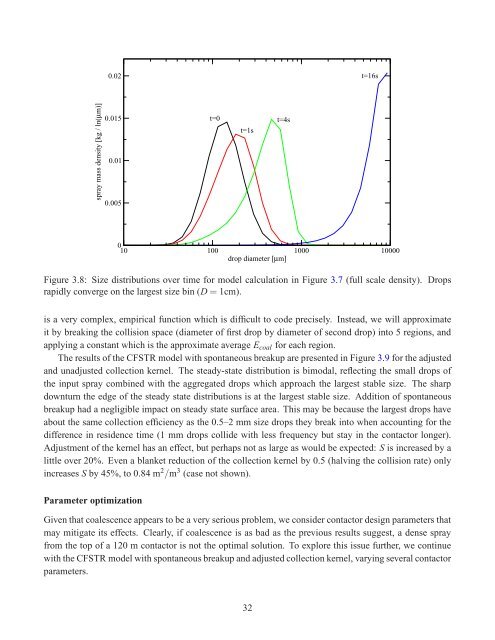Capturing CO2 from ambient air - David Keith
Capturing CO2 from ambient air - David Keith
Capturing CO2 from ambient air - David Keith
Create successful ePaper yourself
Turn your PDF publications into a flip-book with our unique Google optimized e-Paper software.
spray mass density [kg / ln(μm)]<br />
0.02<br />
0.015<br />
0.01<br />
0.005<br />
t=0<br />
t=1s<br />
0<br />
10 100 1000 10000<br />
drop diameter [μm]<br />
Figure 3.8: Size distributions over time for model calculation in Figure 3.7 (full scale density). Drops<br />
rapidly converge on the largest size bin (D = 1cm).<br />
is a very complex, empirical function which is difficult to code precisely. Instead, we will approximate<br />
it by breaking the collision space (diameter of first drop by diameter of second drop) into 5 regions, and<br />
applying a constant which is the approximate average Ecoal for each region.<br />
The results of the CFSTR model with spontaneous breakup are presented in Figure 3.9 for the adjusted<br />
and unadjusted collection kernel. The steady-state distribution is bimodal, reflecting the small drops of<br />
the input spray combined with the aggregated drops which approach the largest stable size. The sharp<br />
downturn the edge of the steady state distributions is at the largest stable size. Addition of spontaneous<br />
breakup had a negligible impact on steady state surface area. This may be because the largest drops have<br />
about the same collection efficiency as the 0.5–2 mm size drops they break into when accounting for the<br />
difference in residence time (1 mm drops collide with less frequency but stay in the contactor longer).<br />
Adjustment of the kernel has an effect, but perhaps not as large as would be expected: S is increased by a<br />
little over 20%. Even a blanket reduction of the collection kernel by 0.5 (halving the collision rate) only<br />
increases S by 45%, to 0.84 m 2 /m 3 (case not shown).<br />
Parameter optimization<br />
Given that coalescence appears to be a very serious problem, we consider contactor design parameters that<br />
may mitigate its effects. Clearly, if coalescence is as bad as the previous results suggest, a dense spray<br />
<strong>from</strong> the top of a 120 m contactor is not the optimal solution. To explore this issue further, we continue<br />
with the CFSTR model with spontaneous breakup and adjusted collection kernel, varying several contactor<br />
parameters.<br />
32<br />
t=4s<br />
t=16s








